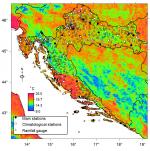Who's onlineThere are currently 0 users and 6 guests online.
User loginBook navigationNavigationLive Traffic MapNew Publications
|
Spatial statistics conference 2011Next year a large international conference on spatial statistics will be held in Enschede, the Netherlands. For more info see: www.spatialstatisticsconference.com; I have been invited, together with a number of other open source enthusiasts, to talk about possibilities of combining statistics and geographical computing. Down-below is a short summary of my lecture. Title: "Worldmaps: building global covariates for automated mapping" Abstract: Tomislav Hengl is a senior research at the ISRIC World Soil Information institute, Wageningen University. Tom specializes in analysis of various environmental spatio-temporal data and develops automated tools for geo-processing large environmental datasets. He is currently involved with the Global Soil Mapping project (GlobalSoilMapping.org), which aims at building high resolution soil property maps of the world. Tom is also vice-chair of the international research society Geomorphometry and vice-chair of the IUSS Working Group on Digital Soil Mapping. He has edited a DEM data processing manual (...) and an open access book on geostatistical mapping. He regularly organizes summer schools on spatial data analysis using FOSS for PhD students called GEOSTAT. The presenter maintains a global repository of publicly accessible layers called "worldmaps". This repository now consists of cca 100 unique layers, which can potentially be used to improve geostatistical mapping of any environmental variable. He will discuss the role of the worldmaps repository for automated mapping applications going from mapping of species distribution to spatio-temporal interpolation of meteorological variables. Such multi-thematic repository could be used to improve the existing intamap package by extending the automated interpolation algorithms to regression-kriging based methods. Here a list of methodological issues need to be solved: how to select optimal subset of covariates, which regression model to use, how to reduce multicolinearity and how to match spatial and temporal resolution of the gridded data. His presentation will include a number of case studies demonstrating geostatistical mapping using open source software tools (R+OSGeo) and publicly available covariates. |
Testimonials"Few days ago I have received copies of my book from Lulu.com. The prints are really impressive! If I think about it - Lulu never gave me any physical training about how to make a book cover, how to optimize the cost/readability balance etc; I only followed instructions on their website and submitted the document myself; and now I am looking at prints which are exactly what I would expect from a professional publisher." Poll |




Recent comments
7 years 37 weeks ago
8 years 2 weeks ago
8 years 10 weeks ago
8 years 23 weeks ago